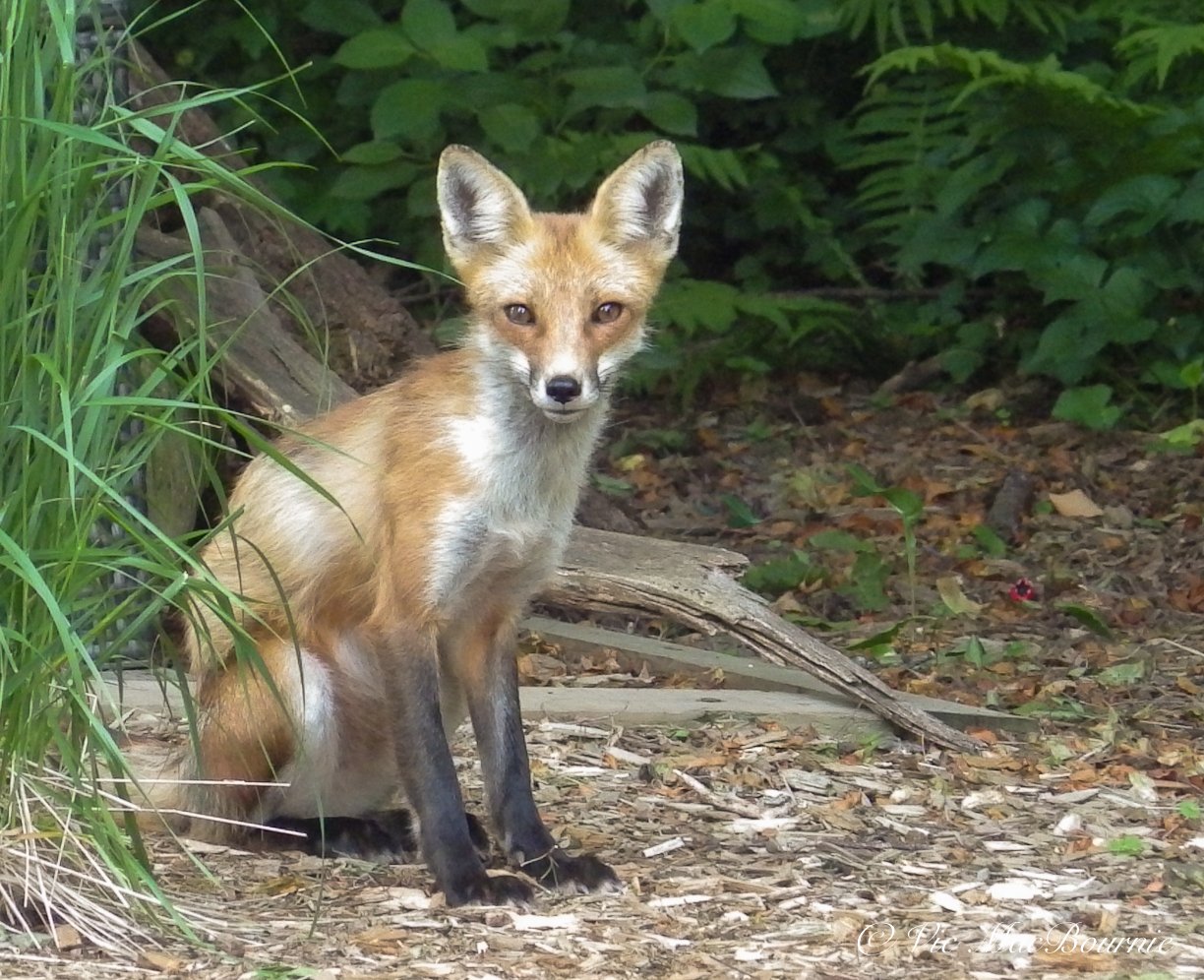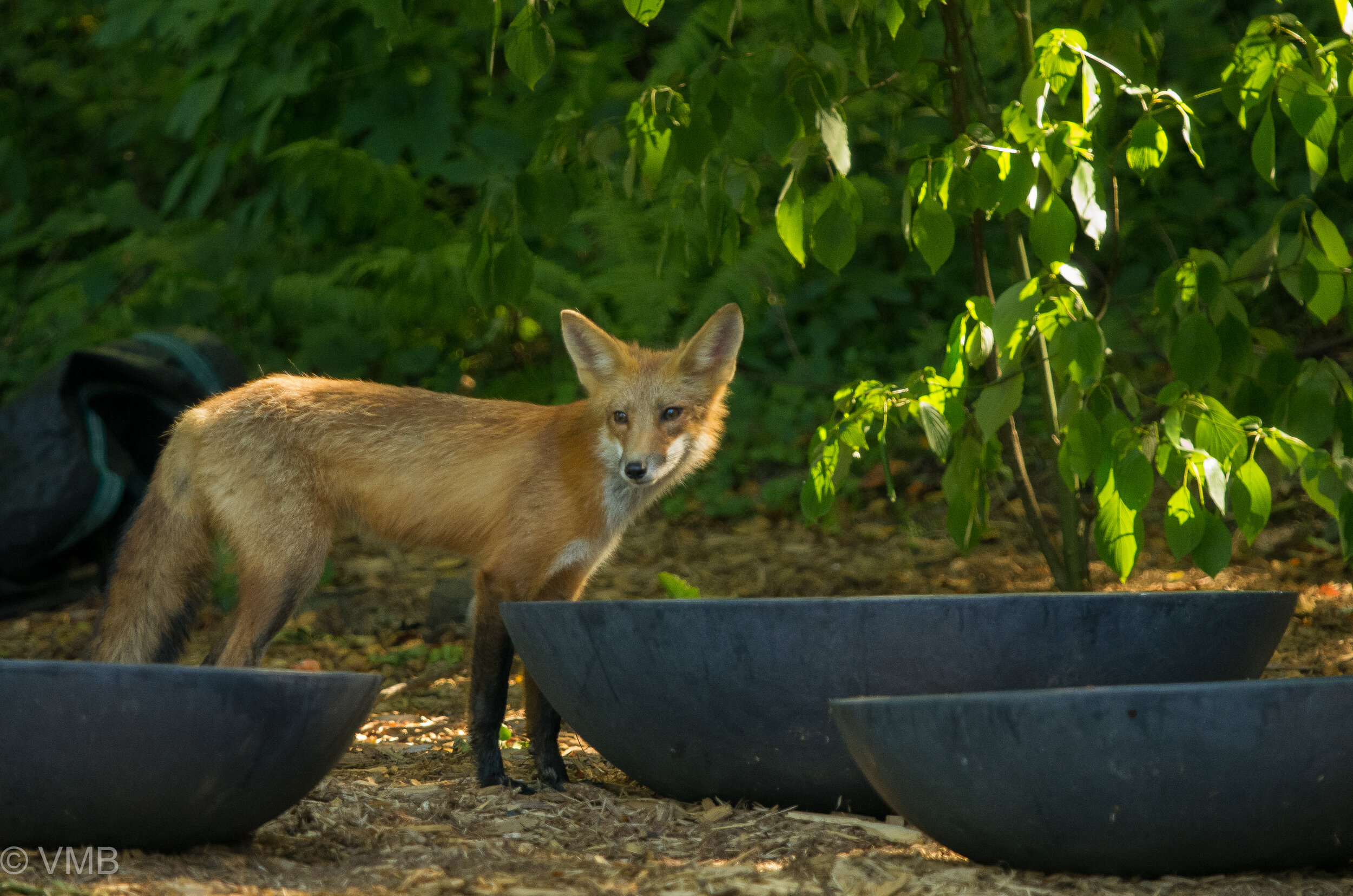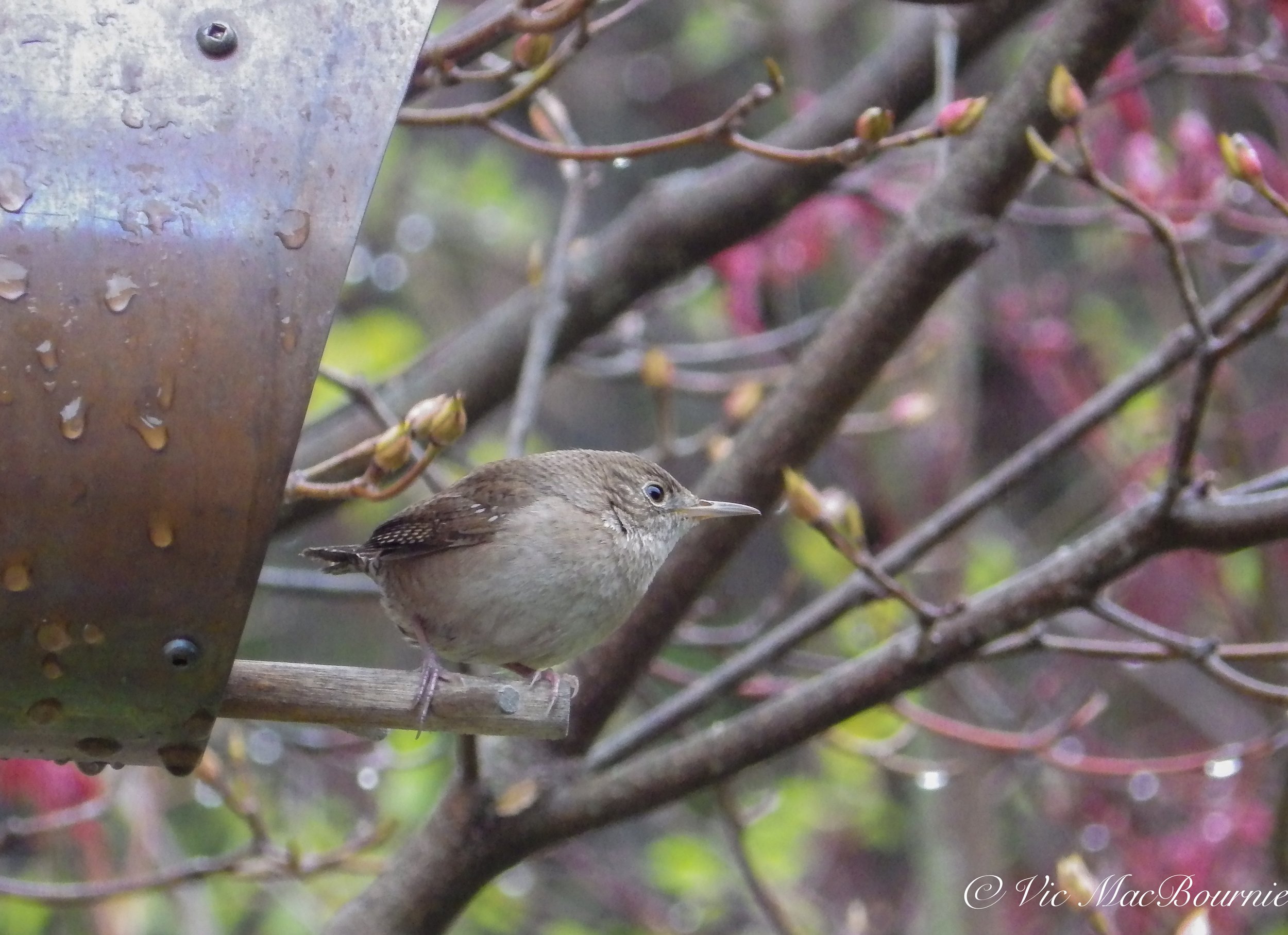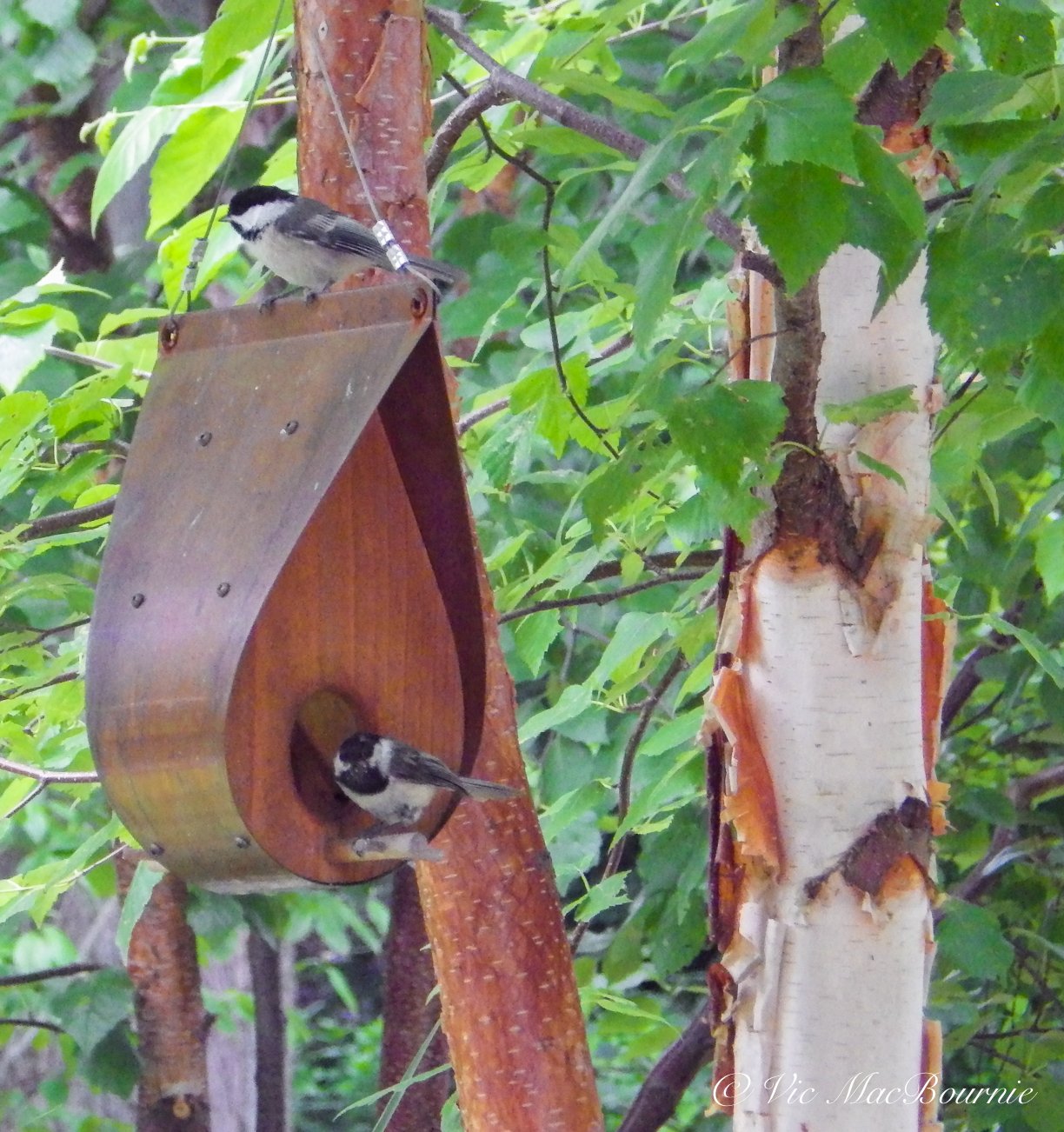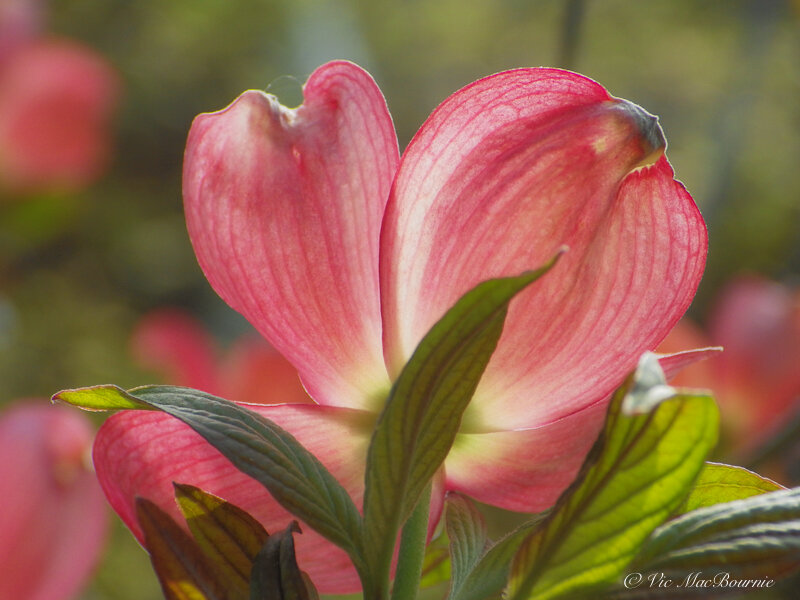Tips to photograph wildlife in your woodland garden
Creating the right environment to be successful in the garden involves a lot of hard work. But, in the end, it pays off. It’s not luck that you saw an oriole, a fox or hummingbird in your garden. It’s the result of that hard work you put in earlier to create the right conditions.
Bridge camera is great choice for garden photography
One of our neighbourhood foxes dropped in for its daily visit. It helped that I was armed with my camera on a monopod and my favourite lens.
This fox image is an example of how the right environment created an opportunity to capture an image that presented itself.
It began with a decision to work on getting a good image of a hummingbird feeding at a native Cardinal flower, but ended hours later with a memorable image of a fox.
Let me explain.
The cardinal flower was at its prime and I knew that, if I wanted to use it to get an image of a hummingbird feeding, I needed to act swiftly. So I set the camera on a tripod, filled up my coffee and waited.
(If you are interested in exploring garden photography at a higher level, be sure to check out my comprehensive post on the Best camera and lens for Garden Photography.)
If you are looking for a new camera or lens, check out B&H Cameras & Video for a complete line of cameras and lenses.
And, if you are wondering how a point-and-shoot digital camera that’s more than 10 years old can perform in the garden, be sure to check out my post on the Canon PowerShot Elph 500 HS.
The hummers came to the feeders surrounding the Cardinal flowers but only stopped at the flowers three times for a brief moment.
About three hours into the shoot, I noticed a fox standing by our shed looking my way. It was by no means stressed by my presence. In fact, it seemed perfectly happy to share the yard with me provided we stayed at a comfortable distance.
How often have you been in the yard and a great photographic opportunity presented itself to you? Too often, we are not prepared. Chances are, all we have is our smart phone by our side and the resulting image is nothing but a poor replica of a memorable moment.
But on this day I was in luck. The camera was already set up with my favourite 300mm F4.5 lens on a monopod.
I couldn’t ask for a better situation. Even our dog Holly had yet to notice the fox that trotted over to our three large water bowls and helped herself to a long drink.
A few quick bursts of photos from the 35mm DSLR camera and off she went. Like a ghost. There one moment … the next, gone. It was over as quickly as it began.
The lesson learned was simple: Be prepared.
Today, even if I just go out to enjoy my morning coffee, I always have a camera by my side ready for action. Sometimes it’s a simple “Travel camera” (read my travel camera review here) with a wide angle to short telephoto lens that is great for basic garden shots but will not likely get you close enough to most wildlife.
If you are looking to upgrade your camera equipment – be it a new camera body or lens – be sure to check out KEH Camera Exchange for the best prices on excellent used equipment. You can also trade in your used gear to help curtail the cost of new equipment.
Most likely, it is my versatile “Bridge camera” that allows me to shoot everything from long telephoto images of wildlife, including birds and butterflies, to sweeping wide-angle garden vistas, to macro shots of flowers and insects.
On this day, I happened to have my 300mm lens on the camera and ready to go, which made capturing the fox image possible.
This young fox decided to pose for me for a minute giving me time to focus the Pentax X5 “Bridge” camera to capture the image. I needed to use the full zoom power of the X5 (500mm) to capture the image.
More recently, however, I have a “bridge camera” with me. I have used the camera for more than a year now and have come to appreciate its versatility, with its ability to go from extreme telephoto to wide angle and even a very usable macro mode.
Bridge cameras, which are offered by all the major camera manufacturers, can be the perfect camera choice for garden photographers looking for a single extremely versatile camera that is at home photographing garden vistas as it is birds and other wildlife. Add to that versatility the ability to get in close to flowers for macro photography and it’s hard to believe that everyone is not lining up to purchase one. These cameras can be described as mid-priced cameras situated between a simple point-and-shoot and a more serious 35mm SLR with a complete line of lenses. Bridge cameras look like a typical digital single lens reflex (DSLR), but without the interchangeable lenses.
The bridge camera offers a built-in lens sporting a wide angle to long telephoto lens. The combination creates an easy-to-carry-around versatile camera that can deliver very good results with a little practise.
But they are not by any means perfect.
My bridge camera uses an electronic viewfinder in addition to the back LCD screen to view the image. The electronic viewfinder takes getting used to and falls far short of a optical viewfinder found in traditional DSLRs. To add to the difficulty of using the Bridge camera is a significant “shutter lag” meaning an excessive amount of time between when you press the button to take the image and the time it is actually taken. This shutter lag can mean the difference between getting the shot and missing it entirely.
In addition, because most of these cameras are so dependent on electronic viewfinders and the electronic zooming of the lens, some of these cameras tend to exhaust your batteries quickly, especially if you use the large back LCD screen as your primary viewer or to check your images regularly. My camera uses regular AAA batteries, which can be convenient when you are travelling, but compared to rechargeable batteries, can also be expensive to use. The other issue I have with the Pentax (which is no longer available) is the fact I cannot easily add filters to the front of the lens. This may not be a problem for most photographs, unless of course, you need to use a polarizing filter to remove glare from leaves or a pond.
Like most Bridge cameras, the Pentax X-5 bridge camera that I am using came with a very long 26X telephoto lens (the equivalent zoom for traditional 35mm cameras of about 22-580mm.) Most bridge cameras come equipped with a lens that provides the photographer with both a solid wide angle lens as well as a super-long telephoto lens.
Bridge cameras like my Pentax X-5 also come equipped with an impressive macro feature making it the perfect camera to carry with me into the garden for casual macro shots. For more serious macro photography, I will mount a 50mm or 100mm dedicated macro lens on a 35mm SLR camera.
Being prepared, having the right tools at hand and, of course, some luck on your side can mean the difference between getting the shot and missing it.
Even seeing wildlife, let alone getting good photos of them, depends on a lot of factors going your way.
Luck certainly plays a role in any shot, but I like to think that it plays a smaller role than most people think.
A macro image of a clematis taken by the Pentax Bridge camera the X5, on macro mode. This shows the versatility of the camera and its lens that is able to go from long telephoto (see above image of the Fox) to extreme macro without changing the lens.
Being out in the yard for more than four hours patiently waiting for the hummingbirds to cooperate creates the opportunity to be successful. Still, I was unsuccessful getting that shot of the hummingbird. Instead, I had to “settle” for the fox shot.
I like to think you create your own luck.
Setting out large water bowls meant to provide local wildlife with a fresh water source helped create that opportunity for the photograph.
Creating a natural garden, providing a source of natural food and moving water in the form of bubbling rocks and fountains, not using pesticides, having woodpiles … these all provide the right environment to getting the photograph, or the opportunity to observe the wildlife that call our property home.
PopPhoto website lists their favourite Bridge Cameras in this informative article starting with the best overall camera going to the Sony Cyber-shot DSC-RX10 IV, the Canon PowerShot SX70 HS as the best Wildlife camera and the Panasonic Lumix FZ80 as the best budget camera.
It doesn’t have to be a fox. It could have been a bird, a butterfly a reptile, or even a photograph of a beautiful tree or grouping of flowers.
The day before this shot was taken, I was trying to capture some photographs of birds enjoying my new solar-powered fountain, when a little chipmunk decided to hang out with me for a while. So I got “lucky” and was able to get some great shots of the chipmunk too.
Getting lucky is really about creating the right environment to get photographic opportunities and then taking advantage of these opportunities.
It’s the same in your everyday life. Put yourself in the best environment to succeed and chances are you will.
Getting up early, spending time in our gardens, getting up close and intimate with flowers. These all create the opportunities to be successful.
I’ll be out again soon working on getting the shot of the hummingbird at the cardinal flower. Maybe I’ll get “lucky” and the hummer will cooperate this time.
This page contains affiliate links. If you purchase a product through one of them, I will receive a commission (at no additional cost to you) I try to only endorse products I have either used, have complete confidence in, or have experience with the manufacturer. Thank you for your support. This blog would not be possible without your continued support.
Building your Woodland: One Tree at a time
Dream of what your woodland garden can be and we will work together to make it real. By using native and non-native trees, plants and flowers, you can transform your garden into a wildlife haven. Then spend the day photographing the nature around you.
Woodland wildlife garden needs time to mature
A woodland garden can be as big or as small as you want. Start with a single tree in your yard and try to imagine what that tree can become.
Remember a woodland garden can take time to mature into perfection. Like a freshly-built home that lacks the layers living brings to it, a woodland needs that same time to develop the multiple living layers that make it the inviting place we want to experience. It too needs its spirit; one that starts deep in the soil and stretches high into the upper layers of the forest canopy. If you are just starting out developing your woodland garden design, the first rule to understand is that a woodland garden is all about layers. Three layers really, but you could argue four even six and still be correct.
It all starts with the upper canopy
The top layer, the upper-level canopy, is what builds the strength of the woodland over time. If you do it right, the middle layer is where much of the beauty resides. Then there is the shrub layer and finally the ground layer, also not without its share of beautiful things. The ground layer, appropriately made up of ground covers, forms a protective layer that encourages all that is above it to prosper.
Early morning offers a different experience in the Woodland for both photographers and dreamers. Get up early, catch the light, and sneak in an afternoon nap.
Maybe, if you are like me and bought into an older neighbourhood, you are already blessed with a mature tree or several that helps to create the critical upper canopy. If you are not blessed with any large trees on your site, that large maple growing in your neighbour’s yard casting its lovely shadow over your yard will do the trick too. Remember though, your neighbour could cut that tree down and your upper canopy can disappear in an afternoon. Better to plant your own as soon as possible as a backup to your grumpy neighbour’s tree.
This photo illustrates the layering of our mature woodland garden. A large locust and tulip tree form the upper canopy, while a mautre Cornus Kousa in full flower forms part of the mid-canopy. The kousa is joined by serviceberry, redbuds and Cornus Florida in the lower canopy of this area of the garden. Ostrich ferns fill in as the primary ground cover.
Large trees form the upper canopy
When we talk upper-level canopy, we’re talking the big boys of the tree world.
Think maples, locusts, lindens, oaks and a host of other native trees that will grow large enough to eventually tower over the garden.
If you live in the Carolinian zone (link to my post) or a similarly appropriate area and need a quick canopy, consider planting a couple of Tulip trees. They are fast-growing native trees, growing up to 35 metres tall. In fact, they are among the tallest and straightest trees in the forest. In fact, they were often the tree used as telephone poles because of their straight growth habits. Their canopy can be trimmed up high as they shoot to the sky, and the shade they throw is open enough to allow understorey plants to grow happily.
Tulip trees have a spectacular yellow-green 5 centimetre long spring blooming, tulip-shaped flowers. Although the fast-growing tree is not the best host of insects and caterpillars that provide food for birds, the seeds of the tulip tree grow every year and are a source of food for birds and small mammals.
Oaks are kings of biodiversity
If you are looking for the perfect tree to form your upper canopy, you would be hard pressed to do better than one of the mighty oaks. Consider planting an oak near your tulip trees where it will grow up to provide a future canopy after the tulip trees have served their immediate goal of providing a fast and effective canopy in the short-term.
What makes Oak trees so important?
As Douglas W. Tallamy explains in his book Bringing Nature Home: How you can sustain wildlife with Native Plants, (link to my review of the book) a single white oak tree can provide food and shelter for as many as “22 species of tiny leaf-tying and leaf-folding caterpillars.” These combined with all of the other “lepidopterans (moths and butterflies), heteropterans (true bugs), homopterans (aphids, plant hoppers,and scales), thysanopterans (thrips), orthopterans (katydids, grasshoppers, and crickets), … that develop on white oaks are considered s well, you can appreciate how important this one plant species is to the mintenance of biodiversity.
In fact, a single oak can support up to 534 different species and leads the list of important native trees providing biodiversity in our forests and woodlands.
In Tallamy’s list, The willow is second supporting 456 species followed by cherrry and plum (also 456); birch trees (413); poplar, cottonwood (368); crabapple (311), Maple, box elder (285), Elm (213); pine (203); Hickory (200); Hawthorn (159); spruce (156) …”
If attracting birds and creating a biodiversity of insects, caterpillars, moths and butterflies in your garden is important to you, I urge you to get Tallamy’s book and use it as a bible for creating your backyard landscape design.
Blessed with mature trees in our yard
When we bought our home here in southern Ontario some 25 years ago, my wife and I were blessed with several large trees on the property, including two lovely locust trees, a large linden and Austrian pine in the backyard and two large maples in the front yard of the property. Since then, more trees big and small (at last count 28) have joined the originals to help form the foundation of our woodland.
The understorey: Where the (real) fun starts
The middle layer is the one that can really shine in the woodland.
This is where you can introduce a myriad of flowering trees. Think flowering dogwoods, both the native variety (Cornus Florida) with a multiple of hybrids or the prolific Kousa Dogwoods that flower later in the season after the leaves appear on the branches. A combination of the two gives you a magnificent show from early spring into summer. Then, if you have room, intermingle a couple of Redbuds (link to my post on Redbuds) or Serviceberries between the dogwoods. Their ethereal flowers are absolute showstoppers in any garden big or small.
And, if that’s not enough, how about a couple of azaleas growing beneath the Dogwoods, Serviceberries and Redbuds. That’s a showstopper.
These are just a few ideas to think about while you contemplate your Woodland. Future posts will delve a little deeper into the different layers, so stay tuned. For example here is a post on three of my favourite groundcovers. Here is another post on a favourite groundcover for a hot dry location. This post looks into moss as a ground cover and plants that create a similar experience as moss in the garden.
I would love to hear some of your planting ideas for your top two layers your Woodlands. Share them with us below in the comment section.
This page contains affiliate links. I try to only endorse products I have either used, have complete confidence in, or have experience with the manufacturer. Thank you for your support.

